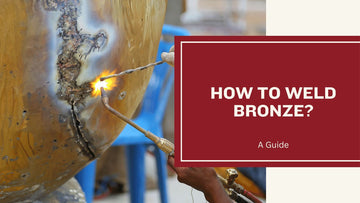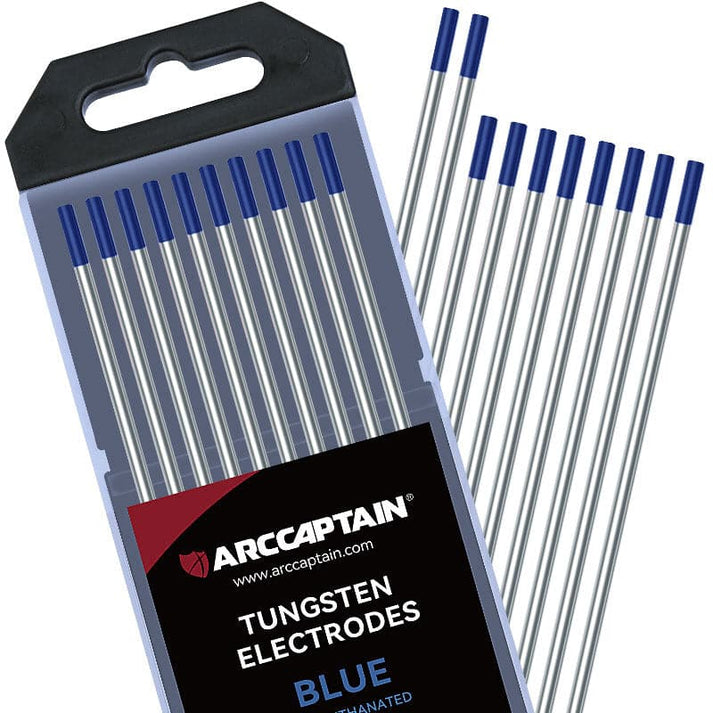
Welding bronze, a metal celebrated for its strength and elegance, can be a challenge, even for experienced welders. Used in everything from art to machinery, bronze requires specific know-how and techniques for effective welding.
This guide is here to navigate you through the essential tools and methods for creating durable, beautiful bronze welds. We'll explore the various types of bronze, identify the best welding techniques for this distinct material, and share practical tips for successful welding.
Whether you're a seasoned professional aiming to polish your technique or a hobbyist tackling new projects, this guide has all you need to master bronze welding.
Understanding Bronze as a Welding Material
What is Bronze?
Bronze is a copper-based alloy that includes materials such as brasses and bronzes. It is often used for its strength, corrosion resistance, and aesthetic appeal in welding projects.
Understanding the different types of bronze and their characteristics will help you choose the right welding techniques and materials for your project.
Different Types of Bronze and Their Properties
Bronze is a popular material for welding because it's strong and looks good. Welders use different types of bronze, each with its own uses.
- Silicon Bronzes are used a lot for welding. They have silicon in them which makes them flow well when melted. People like to use them for making art or welding parts that will show.
- Aluminum Bronzes are really tough. They have aluminum mixed in which helps fight wear and tear. This type of bronze is great for things that need to last, like boat parts or heavy machinery.
- Phosphor Bronzes contain phosphorus. This makes them stick well when you weld them. You'll see these bronzes in electrical work because they conduct electricity well.
- Manganese Bronzes have manganese added. This gives a strong weld that can handle a lot of pressure. They're good for building structures that must be very sturdy.
Bronze Characteristics and Uses
Bronze comes in various types, including brasses and bronzes. It has excellent corrosion resistance and is often used in marine applications, sculptures, and musical instruments. Bronze also has good thermal and electrical conductivity, making it suitable for welding components that require these properties.
Welders commonly use bronze for architectural metalwork, joining bronze to steel or stainless steel components, repairing antique bronze castings, or creating artistic sculptures. Understanding the specific characteristics of the type of bronze being welded is essential to ensure a successful weld.
Now let's dive into the welding techniques for bronze such as TIG welding, MIG brazing, and oxy-acetylene welding.
Welding Techniques for Bronze
TIG welding, MIG brazing, and oxy-acetylene welding are the most common techniques used for welding bronze. Each technique has its own advantages and challenges, so it's important to choose the right one based on the specific project requirements.
TIG Welding
TIG welding, also known as Gas Tungsten Arc Welding (GTAW), is a precise and versatile method for welding bronze. This process uses a non-consumable tungsten electrode to create the weld, along with a separate filler material if needed.

10/Pack Color-coded Tungsten Electrodes 2% Blue Lanthanated Red Thoriated Tungsten
TIG welding offers better control over the heat input and allows for high-quality welds on thin bronze materials without causing distortion or burn-through. It's important to adjust the settings according to the thickness of the bronze, ensuring proper penetration and fusion while avoiding overheating.
MIG Brazing
Moving on from TIG welding, another effective technique for welding bronze is MIG brazing. This method involves using a filler metal to join the bronze pieces together. The process requires less heat compared to traditional welding, which helps in preventing distortion and damage to the base metal.
MIG brazing also produces strong and clean welds, making it an efficient choice for welding bronze sculptures, castings, or any other copper alloys.
When using MIG brazing for welding bronze, it's important to select the right filler metal that matches the composition of the base metals. Proper cleaning and preparation of the materials are crucial to ensure a successful weld.
Oxy-acetylene Welding
When transitioning from MIG brazing to oxy-acetylene welding for bronze, it's essential to understand that oxy-acetylene welding is a versatile and commonly used method for joining bronze.
It involves using a torch that combines oxygen and acetylene gas to create a high-temperature flame. This intense heat allows for precise control over the welding process, making it ideal for intricate or detailed bronze work.
Oxy-acetylene welding can be particularly effective when working with thin sections of bronze or when brazing dissimilar metals together. Additionally, the flexibility of the oxy-acetylene flame makes it well-suited for both fusion welding and brazing processes on various types of bronzes and copper alloys.
Tips for Successful Bronze Welding
To ensure successful bronze welding, it is important to properly prepare the materials, choose the right filler metal, and control the heat and penetration during the welding process.
These tips below will help in achieving strong and durable bronze welds.
Preparing the Materials
To prepare the materials for welding bronze:
- Clean the surfaces of the bronze pieces to be welded using a wire brush or grinder. This removes any dirt, oxides, or other contaminants that can affect the quality of the weld.
- Ensure that the materials are free from any moisture, grease, or oil by wiping them down with a clean cloth and an appropriate solvent.
- Check for any gaps or misalignments in the joint and make sure they are properly fit together before welding.
- Securely clamp or fixture the bronze parts to prevent movement during welding, ensuring they stay in position.
- Protect yourself with appropriate safety gear such as gloves, welding helmet, and protective clothing before starting any welding operation.
Choosing the Right Filler Metal
When selecting the right filler metal for welding bronze, it's crucial to consider the specific composition of the bronze alloy being welded. Silicon bronze requires a filler metal with a similar silicon content to achieve strong welds, while aluminum bronze necessitates a matching aluminum content in the filler metal.
Nickel-based filler metals are suitable for welding phosphor bronzes and other copper alloys with high nickel content.
The proper choice of filler metal ensures compatibility with the base material, promotes good flow and wetting characteristics during welding, and ultimately contributes to producing high-quality, durable welds that meet industry standards.
Controlling Heat and Penetration
Controlling the heat and penetration during bronze welding is crucial for a successful weld. Here are some key tips to help you achieve this:
- Adjust the heat settings on your welding equipment to ensure that it is appropriate for the thickness of the bronze material.
- Maintain a consistent travel speed to control the amount of heat applied to the bronze.
- Use proper torch angles and distance to regulate the penetration into the base metal.
Common Challenges and Troubleshooting
Joining bronze to other metals can present challenges due to the differences in melting points and expansion rates, but with the right techniques and materials, successful welding is achievable.
Read on to learn more about overcoming common issues when welding bronze.
Joining Bronze to Other Metals
When welding bronze to other metals, it's important to consider the differences in melting points and thermal conductivity. Using a suitable flux can help ensure a strong bond between bronze and other metals.
Preheating the base metal can also aid in achieving a successful weld without causing excessive stress on the materials, especially when joining bronze to steel or stainless steel.
Understanding these principles is crucial for creating durable joints between bronze and other metals. It involves careful consideration of material compatibility, heat control, and proper filler metal selection to achieve high-quality welds that meet industry standards and safety requirements.
Repairing Bronze Castings
When repairing bronze castings, it's crucial to ensure the surface is clean and free from any contaminants. Use a wire brush or sandpaper to remove any impurities, allowing for better adhesion during the welding process.
Additionally, preheating the entire casting can help prevent cracking and ensure even heat distribution when applying the welding filler metal. Remember to choose a filler material with similar composition to the original bronze casting for optimal results.
Inspect the repaired area thoroughly for any cracks or defects after welding, ensuring structural integrity. If needed, use appropriate tools like grinders or files to smoothen out any rough spots on the repaired casting.
Conclusion
In conclusion, welding bronze is an essential skill for every welder. These techniques are practical and efficient in achieving strong bronze welds. Have you considered incorporating these methods into your welding practice? The impact of mastering bronze welding can lead to significant improvements in your work.
Further reading on advanced bronze welding techniques will enhance your expertise. Take the first step towards mastering bronze welding today!
Frequently Asked Questions
1. What do I need to start welding bronze?
To weld bronze, you will need the right welding equipment like an oxy acetylene torch, appropriate welding rods, and safety gear to protect yourself.
2. Are there special rods for welding bronze alloys?
Yes, you must use specific bronze welding rod types designed for joining bronze alloys together effectively.
3. Can anyone learn how to weld bronze?
With practice and learning proper techniques, most people can learn how to weld bronze. It's important to have training and possibly get a certification in the process.
4. What safety steps should I take when welding with bronze?
Always wear protective clothing, gloves, goggles or a helmet when using any kind of equipment used for such tasks; this includes proper handling of fluxeswhich might be harmful if not managed well.
5. Where can I find supplies for my first step into "welding" of such metals ?
You can buy all kinds of necessary materials including your tools from stores that specialize in selling items used specifically by those who work on creating metalwork projects professionally or even as hobbies at home.
